Your teams’ ability to adapt to change has a direct impact on your business’s bottom line.
The thing is, there’s no unique way to embrace change. The change management program you are about to implement depends on your industry, the company’s culture, as well as the business goals you’re trying to achieve.
📚Master the art of communication with our article on Interpersonal Communication and Must-Have Skills.
In this blog post, we will go over some of the most popular change management models you can consider for your business.
Are you ready? Let’s dive in!
Why Choosing the Right Change Management Model Is Important
Driving and inspiring change is a challenge that most organizations are facing today. The times when stability and predictability were the main business priorities are over!
Market transparency, labor mobility, globalization, instantaneous communications and constant access to information force us to get out of our comfort zones and make changes within our organizations.
Change management is the process organizations launch to improve current performance, seize new opportunities or address key issues. A change management process includes a plan, projects and initiatives.
Make change management effortless with great internal comms
These efforts often require changing the current business processes, job roles, and organizational structures as well as updating the technologies used in the organization.
Even though different groups within organizations may look at change management differently, it is extremely important to always address the human side of change in organizational contexts.
But remember that employee communication is the key to driving change.
Indeed, your employees may at first resist change. To make sure that they’re aligned with your strategy, you need to make sure they have a great understanding of the process, the reasons why you’re driving change as well as how it may impact their work.
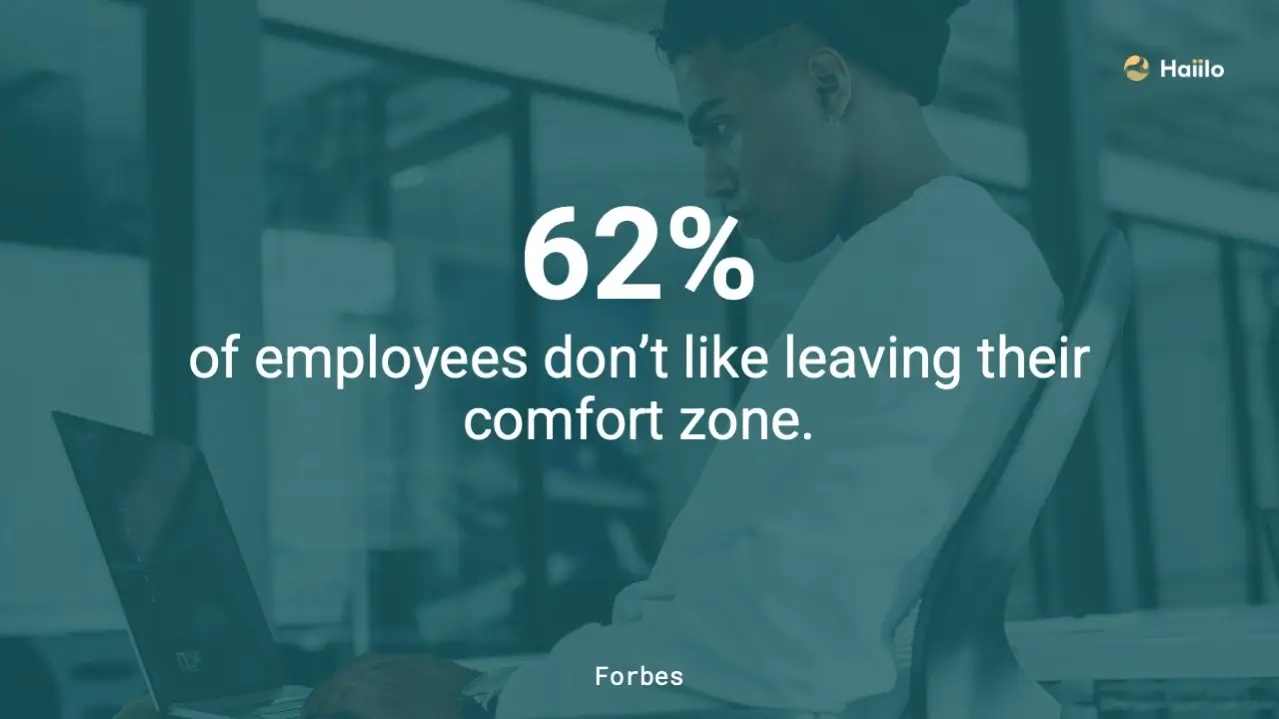
With the rise of remote work, resource issues and surrounding macro economic factors, change management has become one of the main priorities for businesses across the world.
As companies are constantly changing their policies, procedures and business processes, it is crucial to properly manage and communicate them in the entire workplace.
Since every organization has different company values, culture, goals and change objectives, not every change management model fits all.
📹 Check out our Masterclass: 5 Effective Change Management Models
In order to implement changes such as digital transformation or smoothly transition during mergers and acquisitions, it is important to effectively plan ahead and structure the whole project.
In order to do so, it is useful to follow existing change management models.
Let’s take a look at the 5 most popular change management models.
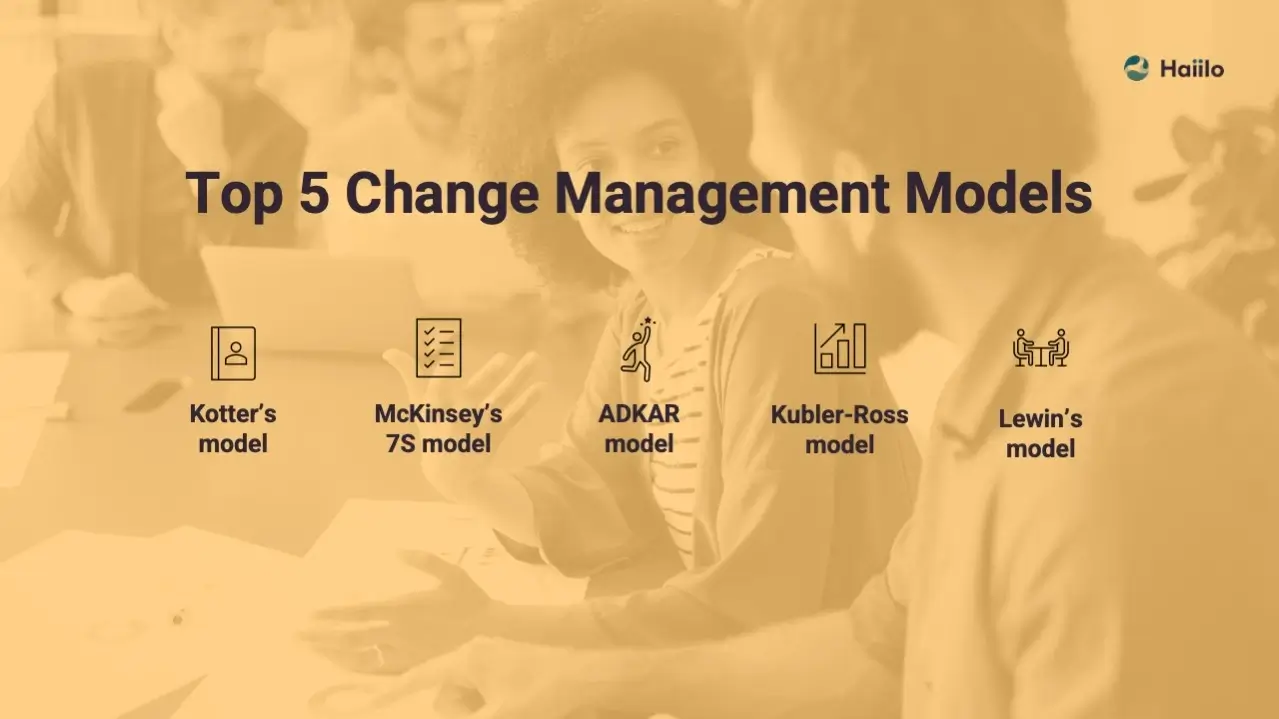
1. Kotter’s Change Management Model
Kotter’s change management theory is one of the most popular and adopted ones in the world.
This model has eight steps, and each of them focuses on employees’ response to change.
- Increase urgency – Creating a sense of urgency among employees may be the best way to motivate and engage them during the process.
- Build the team – Determine the right set of skills and personalities for the team that will be responsible for driving change within the organization.
- Get the vision correct – Take into account not just the strategy but also employees’ creativity, emotions and the project’s objectives.
- Communicate – Be transparent and frequently communicate with people about the changes being implemented.
- Get things moving – Get support, remove the roadblocks and collect feedback in a constructive way.
- Focus on short-term goals – Don’t just focus on the end result. Set small goals and recognize small achievements during the process to boost employee morale.
- Incorporate change – Reinforce and make change a part of the workplace culture. Help employees adjust and reward them for the new behaviors.
- Don’t give up – Changes don’t happen overnight, and obstacles are unavoidable. Be persistent while the process of change management is going on, no matter how tough things may seem.
🧡 Why we like this model
Kotter’s change management model is pretty easy to follow and incorporate. Our favorite part of this model is that it focuses on preparing employees for change rather than change implementation itself.
The focus on employee experience and proper workplace communication is one of the reasons why this is one of the most commonly used change management models.
2. McKinsey 7-S Change Management Model
McKinsey’s 7-S framework or model is one of the longest-lasting change management models out there.
This model consists of 7 crucial categories that companies should be aware of when implementing change:
- Strategy – Strategy is the change management plan that should consist of a step-by-step procedure or future plan.
- Structure – This factor is related to the structure in which the organization is divided or the structure it follows.
- Systems – This stage focuses on the systems that will be used to complete day-to-day tasks and activities.
- Shared values – Shared values refer to the core or main values of an organization according to which it runs or works.
- Style – The manner in which change is adopted or implemented is known as ‘style.’
- Staff – The staff refers to the workforce or employees and their working capabilities.
- Skills – The competencies as well as other skills possessed by the employees working in the organization.
🧡 Why we like this model
Unlike most other models, this model focuses on all the important factors that change may impact.
While most other models represent some kind of a process or workflow, McKinsey’s model simply reminds us of all the business aspects that should be defined before the change strategy is implemented.
3. ADKAR Change Management Model
ADKAR model can be used by Change Managers to find out various gaps in the process so that effective training can be offered to the employees.
Even though the ADKAR model focuses on business-oriented goals, it can be very useful to support employees to more easily go through the process of change.
ADKAR Model stands for:
- Awareness – of the need and requirement for change
- Desire – to bring and be part of the change
- Knowledge – of how to drive change
- Ability – to incorporate the change on a regular basis
- Reinforcement – to keep it implemented and reinforced later on as well.
🧡 Why we like this model
This change management model is a great solution for companies that are trying to look at both the business and people dimensions of change.
Unlike other change management models, this model focuses on the identification and evaluation of the reasons why change is working or not and why desired results are not being obtained.
4. Kübler-Ross Five Stage Change Management Model
This model is different from the others in the sense that it is 100% employee-oriented. The model can also be applied to other life situations such as loss of job, changes in work and other less serious health conditions.
This model helps employers understand better their employees and empathize with them. This model consists of five stages through which your employees may be going during organizational changes.
- Denial – In this stage, employees are not willing to or unable to accept change. This happens because most people show resistance towards change and may not want to believe what is happening.
- Anger – This model assumes that when the news first gets absorbed, anger follows. Denial converts into anger when employees realize that the change is actually happening.
- Bargaining – During the bargaining stage, employees try to get to the best possible solution out of the situation or circumstance. Bargaining is a way for people to avoid ending up with the worst-case scenario.
- Depression – When employees realize that bargaining is not working, they may end up getting depressed and may lose faith. Some of the symptoms include low energy, non-commitment, low motivation and lack of any kind of excitement or happiness.
- Acceptance – When employees realize that there is no point in fighting change anymore, they may finally accept what is happening and may begin to resign to it.
🧡 Why we like this model
We love this change management model because of its focus on employees, their feelings, concerns and needs.
Organizations that manage to understand their employees are much more likely to eliminate some of the biggest barriers towards successful change management.
Because most employees go through the above mentioned feelings, it is extremely important to keep employees informed and to have an effective business communication strategy.
5. Lewin’s Change Management Model
Lewin’s Change Management Model is one of the most popular accepted and effective change management models.
It helps companies better understand organizational and structured change. This model consists of three main stages, which are: unfreeze, change and refreeze.
- Unfreeze: This is the preparation stage where employers must get prepared for change. The crucial step here is to enhance open employee communication explaining why change is necessary. The goal is to overcome employees’ resistance to change as much as possible.
- Change: This is the stage in which change gets implemented. Continuing on the first stage, good leadership and effective employee communications are crucial here.
- Refreeze: This is the stage in which change is accepted and employees go back to their routine. This stage should be considered as almost ever-going. Leaders should make sure that changes are adopted and used even after the change management objectives have been achieved.
🧡 Why we like this model
Lewin’s change management model describes in a very simple way the main 3 stages that every change management process has to go through: pre-change, during change and post-change.
Because of its simplicity, many organizations choose to follow this model when implementing change.
The Example of Using the McKinsey 7-S Change Management Model
Earlier in this blog, we have defined and explained the components of the McKinsey 7-S Change Management Model. Let’s now apply it to the real-world situation, how to deal with a pandemic:
Increase urgency
Employers are responsible for creating urgency about the change. In this situation, urgency around following safety guidelines, new policies, procedures and tips for working from home is important for employers to ensure business continuity.
Build the team in charge of driving change
Depending on a situation, change teams may include different departments. However, getting internal communications departments on board is not an option, it is an absolute must!
In this case, other members of the team should include change management teams, crisis management and communications teams, leaders, managers and HR departments.
They are all responsible for ensuring that employees stay connected, inspired and productive even when they may be physically separated and dispersed.
Align your employees with your vision
Your change communication plan should have a clear vision about the change. Furthermore, it should include clear goals in order for employees to understand how to work together towards those goals.
Setting the clear vision is the only way to get employees’ buy-in and align them with the ultimate business objectives.
Communicate your change management strategy to your employees
Once your define your vision and goals, it is crucial that you communicate them frequently, transparently and openly with your entire workforce, even when you don’t have the best news to share.
Many organizations are now undergoing significant cuts and employee lay-offs as the consequence of the current world situation. Instead of leaving your employees in the dark, you need to make sure that they have access to the important information and updates.
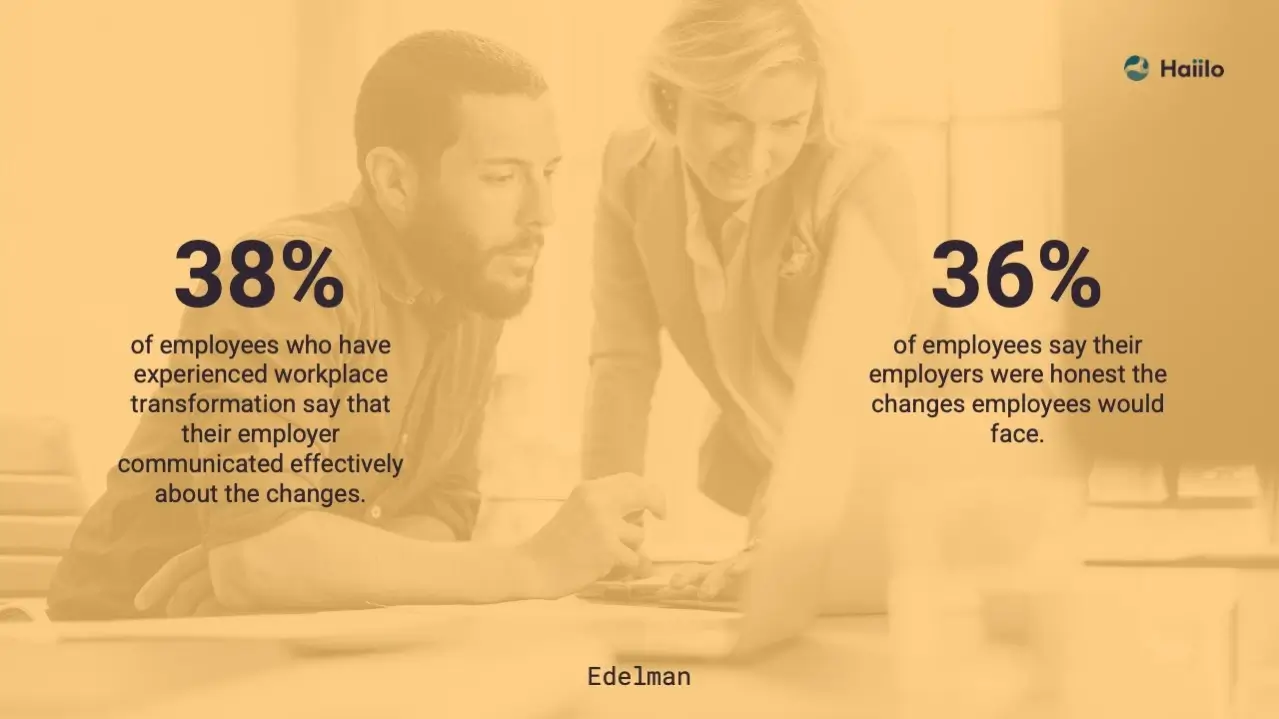
Regardless of the change management model you use, communicating the benefits and consequences of change should always be your priority.
Here are a few questions your change communication plan should include:
- What does change entail?
- What are the goals?
- How employees’ roles may be impacted?
- What is the time frame for it?
- Where to find and access important company updates?
- How to communicate change?
- How to make sure employees embrace change?
Get things moving
When implementing change, it is important to continuously support your employees in order to mitigate their resistance and remove the roadblocks.
Today, the best support you can give to your employees is by keeping them connected and enabling them to share their voice via two-way communication channels.
Allow your employees to ask questions, raise concerns and join daily company conversations. Don’t just send them a mass email announcement and hope that they will read your messages.
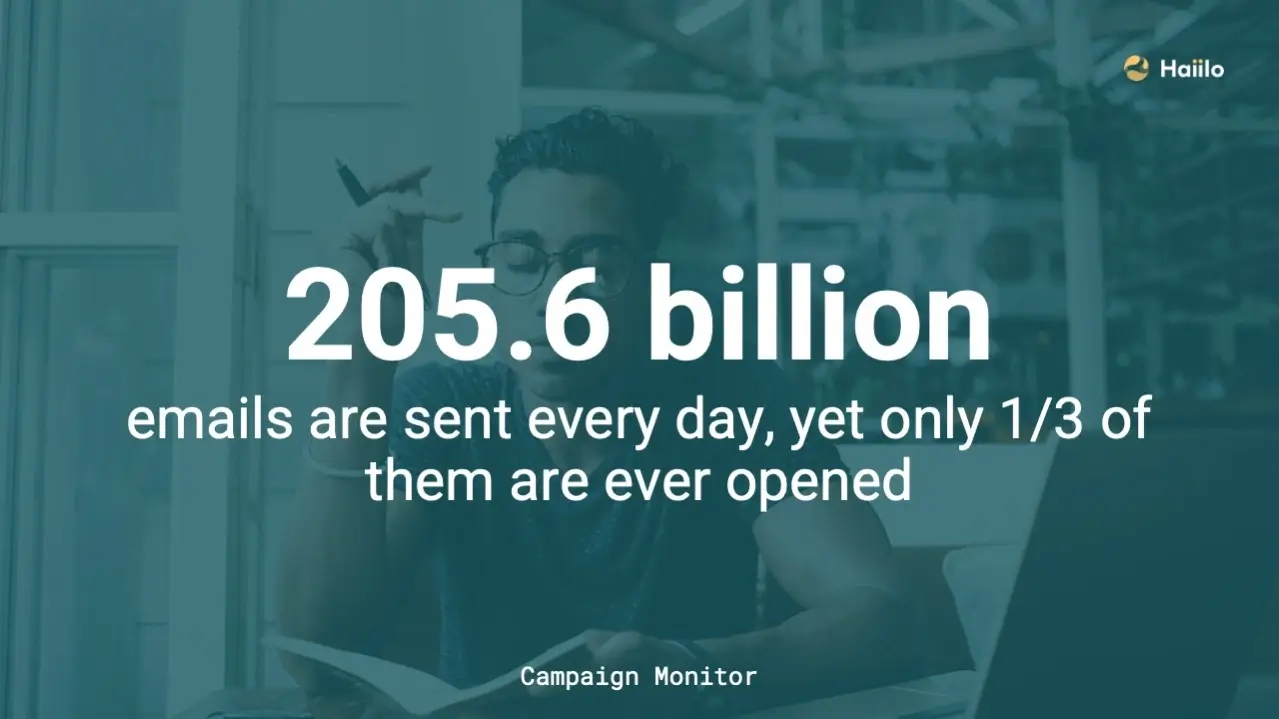
These are the times when many employees are experiencing extensive information overload. Hence, also be careful about only sending relevant and personal information in order to get your employees’ attention.
Include short-term goals in your change management plan as well
Instead of just setting the final goal of your change initiative, set smaller, short-term milestones so that your employees stay motivated throughout the entire process.
For example, if you are planning to keep remote work practice at your workplace, communicate the remote work goals in chunks. Give your employees a way to easily reach and celebrate their success.
Also, encourage them to publicly celebrate their success and the success of others. Use your internal communications solution to share their inspiring success stories with the rest of the workforce.
Incorporate change
Any changes happening within organizations also need to be complemented with a significant cultural transformation. Again, proper internal communications is crucial.
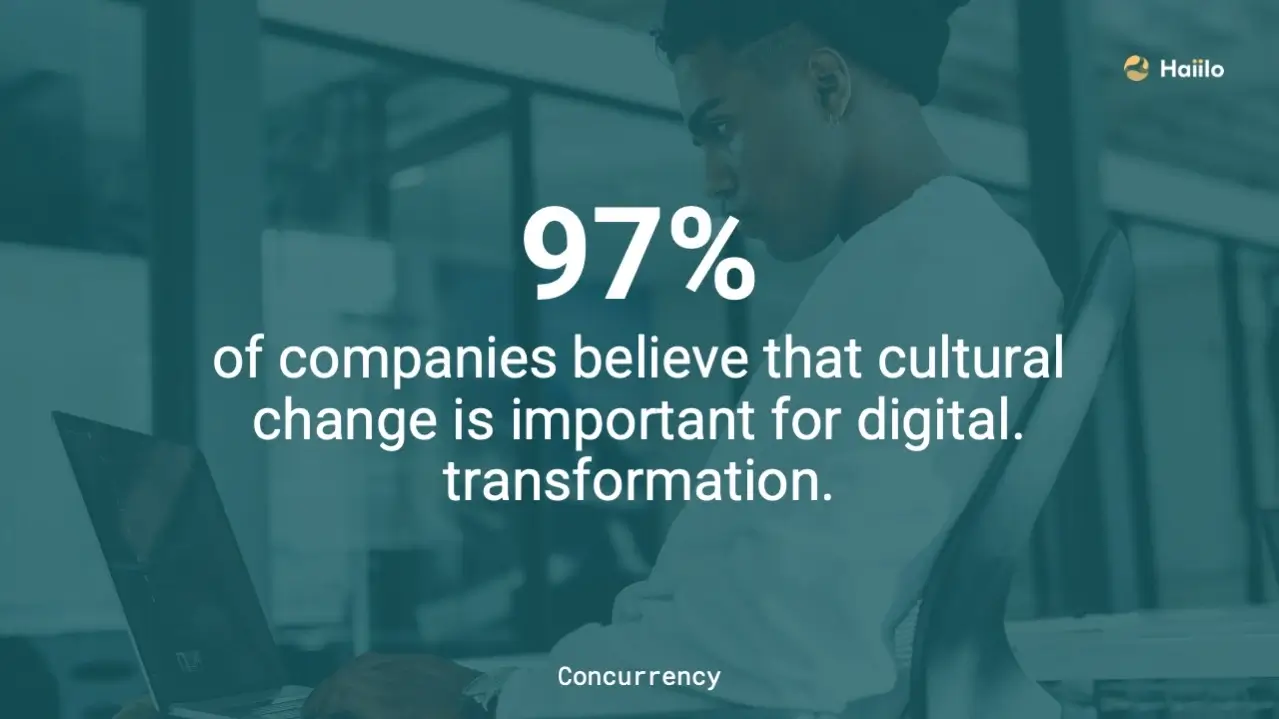
This is why IC departments are now becoming some of the most important strategic business partners who are also driving organizations to become more adaptable and agile.
Don’t give up
Remember that change won’t happen overnight. The process of change management actually never stops.
So, no matter which change management model you chose to use, you need to make sure to continuously encourage and empower your employees to stay aligned.
The current situation is the perfect example to illustrate this point. We all know that COVID-19 is nowhere close to end and be done. It will also have a significant impact on the businesses across the world in the near future.
Why Do 70% of Change Initiatives Fail?
The Harvard Business Review found that most change management projects —70% —fail. Yes, that’s right, 70%.
So, how can we explain that?
An interesting research by PMI found that only 14% of business leaders said that change failures can be chalked up to company’s inability to cope with technology.
The other 86% of failures are related to these challenges:
- Improperly defined objectives (17%),
- Unfamiliar scope (17%),
- Lack of effective communication (20%) and,
- Poor project management skills (32%)
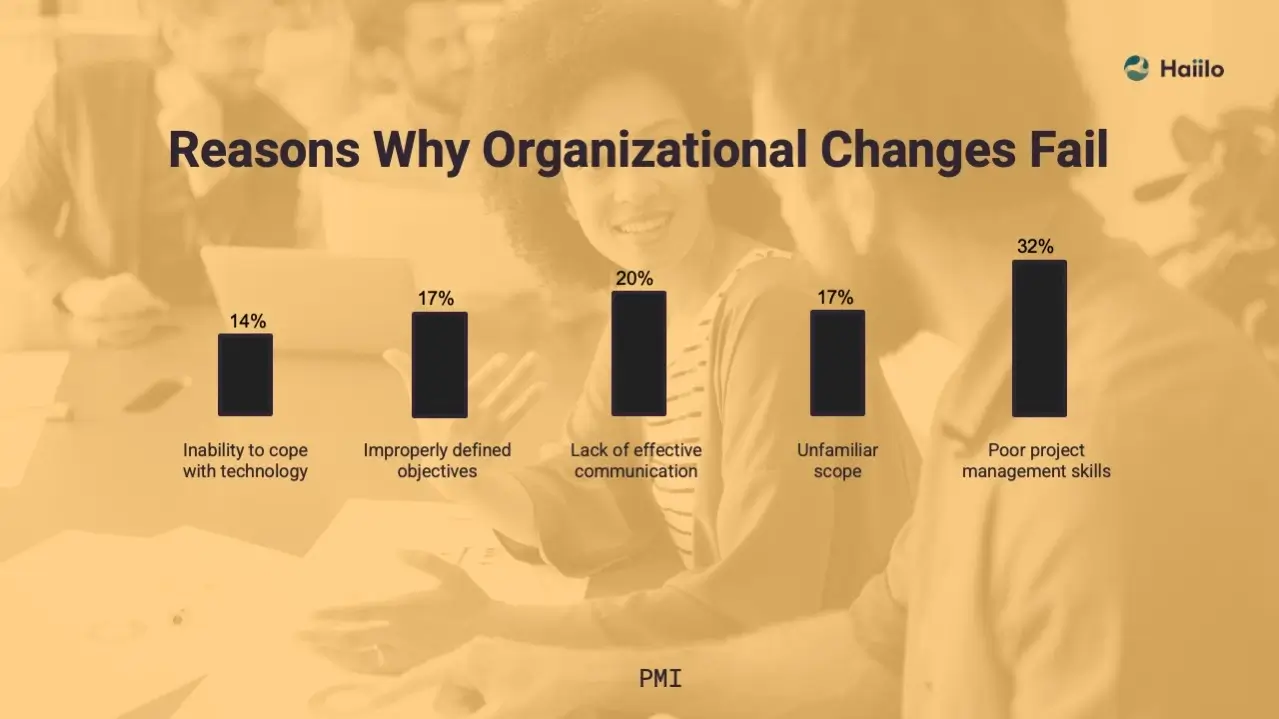
Employee Communication Is the Keystone of Every Change Management Model
Within organizations, change initiatives mostly come from the top down. However, ultimately, it is the employees of your organization who have to change how they do their jobs.
If these individuals are unsuccessful in their personal transitions, and don’t embrace any change and learn a new way of working, the initiative will fail. That said, aligning employees with your business goals is not an easy task.
As we saw from the above mentioned models, employee communication is the central part of every change management model.
If your employees are not on board, implementing change will be extremely challenging.
Make Change Management More Successful with Haiilo
As improper employee communication is one of the main reasons why change management projects fail, companies now have to reconsider their internal communications efforts and switch to new employee communication solutions.
Haiilo is designed to help organizations be more effective in change management.
Think about it: during change management processes, organizations mostly struggle to deliver relevant information to their employees at the right time and to always keep them connected.
With the Haiilo platform, you can reach your workforce in a timely manner, store all the crucial information in one place, personalize your employees’ news feeds based on their roles, interests and location as well as keep track of employee well-being and general mood in the company.
Haiilo’s mobile-first approach and its user friendliness are just some of the reasons why enterprise companies use it as their primary mean of internal communication during change.
In essence, Haiilo helps you to:
- Explain to your employees the change management program you’re about to launch and the reasons why you’re driving change at your organization
- Effectively communicate the impacts change may have on your employees’ work habits and daily jobs.
- Invite your employees to be part of change by collecting their ideas and encouraging them to share their feedback.
- Personalize your messages based on your employees’ roles within the organization, location, interests as well as the languages they speak.
- Share information about your change management program with your entire workforce, no matter where your employees are.
- Keep your remote, deskless and blue-collar employees connected and informed during the process.
- Automate content import from trusted and credible sources of information so you can easily share with your employees educational content related to the digital transformation your organization is undergoing.
- Create channels dedicated to specific topics to avoid confusion during the process.
- Schedule content delivery based on employees’ time zones for better readership.
- Enable your employees to collaborate more efficiently during the change management program.
- Enable your employees to become brand ambassadors by helping them to share with their social networks any important company news and updates on your digital transformation.











